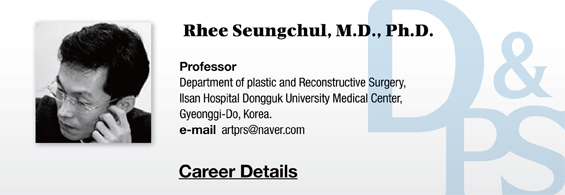
Profile convexity
Profile convexity is a measure of the overall balance among the features of the facial profile. As with the previous landmark, there are many ways to measure the profile convexity [11-14]. Legan and Burstone measured the facial convexity angle (G-Sn-Pg′) in cephalometry, however, they drew a line from the pogonion (Pg’) and measured the angle between G-Sn and this line. This is different from measuring facial photographs [15]. Based on their cephalometric measurements, the facial convexity angle (G-Sn-Pg′) was 14.15±4.65° in Turkish people, 12±4° in Americans and Europeans [16], and 7.74±3.9° in Koreans [17]. These measurements vary widely depending on the study and race.
I believe the cephalometric method is inherently flawed. I have pointed out that the NHP line can be adjusted 6-7° and this can lead to various errors in measuring in different races and ethnicities (Beauty Aesthetics I, D&PS). Therefore, it is imprecise and impossible to use these lines to measure profile convexity for soft tissue or photogrammetric analysis of the face. The better way to measure the overall convexity of facial soft tissues would be to measure the acute angle between the line from the forehead (G) subnasale (Sn) and the line from the Sn to Pg as well as the angle G-Prn-Pg.

Image 3. Profile Convexity Angle in attractive female Caucasians and Asians.
The former angle is called facial convexity angle (angle G-Sn-Pg) and the latter is called total facial convexity angle (angle G-Prn-Pg). facial convexity angle is a measure of the balance among the forehead, upper jaw and lower jaw, whereas the total facial convexity angle considers the protrusion of the nasal tip and is a measure of the balance between the protrusion of the forehead and chin.
According to a study involving Brazilians who are often multiracial [18], the ideal total facial convexity angle was 141.60±5.30° in men and 143.73±3.95° in women. The same study reported that the ideal facial convexity angle was 168.80±4.44° in men and 169.60±3.33° in women. What is interesting is that several people posted on the internet as a response to this study that when they measured these angles in celebrities, the angles did not coincide with the study’s measurements [19]. This shows that one anthropometric measure cannot be the absolute standard for the attractiveness of the facial profile.
According to my findings, the facial profile convexity angle (angle G-Sn-Pg) was about 165.0° in attractive Caucasians and 167.3° in attractive Asians. The total facial convexity angle (angle G-Prn-Pg) which includes the nose was 136.7° in attractive Caucasians and 140.4° in attractive Asians (Image 3).
[Advertisement] PICOCARE - Manufacturer: WONTECH(www.wtlaser.com)
These measurements indicate that what is considered attractive is becoming similar across different races and the preferred facial features of Caucasians and Northeast Asia are closely resembling each other.
In the next issue, we will take a closer look at each of the following aesthetic units of the face; eye, nose, mouth, and chin. We will discuss new references for Northeast Asians and Caucasians considered attractive today based on photogrammetric analysis and compare the new data to the references of traditional aesthetics.
-To be continued
References
1. Davenport, C. B. (1926). Human growth curve. The Journal of general physiology, 10(2), 205-216. ; http://jgp.rupress.org/content/jgp/10/2/205.full.pdf
2. Holdaway RA. A soft-tissue cephalometric analysis and its use in orthodontic treatment planning. Part I, American Journal of Orthodontics , 1983; 84: 1-28.
3. Merrifield LL. The profile line as an aid in critically evaluating facial esthetics, American Journal of Orthodontics, 1966; 52: 804-822.
4. Legan HL, Burstone CJ. Soft tissue cephalometric analysis for orthognathic surgery, Journal of Oral Surgery , 1980; 38: 744-751.
5. Powell N, Humphreys B. Proportions of the esthetic face. , 1984. New York, Thieme-Stratton.
6. Bergman R T 1999 Cephalometric soft tissue facial analysis . American Journal of Orthodontics and Dentofacial Orthopedics 116 : 373 – 389.
7. Anić-Milosević S, Lapter-Varga M, Slaj M. Analysis of the soft tissue facial profile by means of angular measurements. Eur J Orthod. 2008; 30(2):135-40.
8. Burstone C J 1967 Lip posture and its signifi cance in treatment planning. American Journal of Orthodontics 53 : 262 – 284
9. Jang KS, Bayome M, Park JH, Park KH, Moon HB, Kook YA. A three-dimensional photogrammetric analysis of the facial esthetics of the Miss Korea pageant contestants. Korean J Orthod. 2017 Mar;47(2):87-99.
10. Alharethy S. Preferred nasolabial angle in Middle Eastern population. Eur Arch Otorhinolaryngol. 2017 May;274(5):2339-2341. doi: 10.1007/s00405-017-4507-x. Epub 2017 Feb 27.
11. Jamilian A, Darnahal A, Hamedi R, Kamali Z, Toopchi S (2016) Photogrammetric analysis of facial profile in Persian adults. Gen Dent. 64(2):52-5.
12. Wamalwa P, Amisi SK, Wang Y, Chen S (2011) Angular photogrammetric comparison of the soft-tissue facial profile of Kenyans and Chinese. J Craniofac Surg. 22(3):1064-72. doi: 10.1097/SCS.0b013e31821075d8
13. Malkoç S, Demir A, Uysal T, Canbuldu N (2009) Angular photogrammetric analysis of the soft tissue facial profile of Turkish adults. Eur J Orthod. 31(2):174-9. doi: 10.1093/ejo/cjn082
14. Rhee SC, Kang SR, Park HS (2004) Balanced angular profile analysis. Plast Reconstr Surg. 114(2):535-44
15. Bagwan AA. AL-Shennawy MI, Alskhawy MM. Evaluation of soft tissue parameters for adults with accepted occlusion using Legan and Burstone analysis. Tanta Dental Journal 12: 1’ 1-6. https://doi.org/10.1016/j.tdj.2014.06.004
16. Celebi AA, Tan E, Gelgor IE, Colak T, Ayyildiz E. Comparison of soft tissue cephalometric norms between Turkish and European-American adults. ScientificWorldJournal. 2013;2013:806203. doi: 10.1155/2013/806203.
17. Young-jin Kim, Jung-hwan Kim. Characteristics of facial profile preferred by orthodontists. Korean J Orthod, 2001; 31(5): 479~487.
18. Fortes HN, Guimarães TC, Belo IM, da Matta EN. Photometric analysis of esthetically pleasant and unpleasant facial profile. Dental Press J Orthod. 2014 Mar-Apr; 19(2):66-75.
19. http://lookism.net/Thread-Pics-Measuring-profile-subhumanity




















